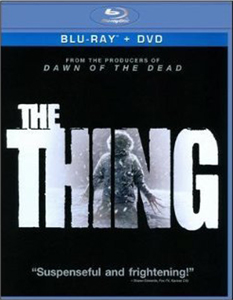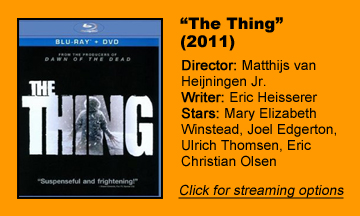I’m a sucker for when franchises expand their continuity into prequels, sequels and spinoffs, so when someone says “Here’s the story of what happened to the Norwegian crew before the events of ‘The Thing,’ ” I’m on board. It took me awhile to get to “The Thing” (2011) because its title makes it sound like a remake rather than the prequel that it is.
But my initial trepidation wasn’t totally wrong, because here’s what writer Eric Heisserer decides happened: Pretty much the same thing as what happened to the American outpost in John Carpenter’s film.
Back to Antarctica
It’s initially bracing to return to frigid and blowing Antarctica, with Canada again effectively standing in under the direction of Matthijs van Heijningen Jr. Archaeologist Kate (Mary Elizabeth Winstead) is tapped to join the Norwegian science base in investigating a creature found in the ice.
Her presence immediately gives “Thing ’11” something not found in “Thing ’82”: a woman. Kim Bubbs’ Juliette is also at the testosterone-laden outpost, but Kate is our main character. Not because she leads the crew, or even the dig, but because Heigningen returns the camera to Kate even when she’s at the back of the room.
Dr. Sander Halvorson (Ulrich Thomsen) is the classic horror movie character who loves the creature too much to develop a healthy fear of it, and here he’s also the man in charge whom Kate has to overcome in order to save everyone.
Building on Bottin
Actually, though, the creature is so ridiculously terrifying – and so immediately destructive – that the Kate-Sander clash soon gets sidelined. When the monster literally bursts out of its block of ice, it struck me as a one-scene illustration of the difference between classic horror films and slick modern versions.
As “The Thing ’11” moves into familiar territory, creature effects legends Alec Gillis and Tom Woodruff Jr. and their team build on Rob Bottin’s groundbreaking practical effects with their own excellent work, which leans toward CGI but not in a bad way.
Among the creepy concepts are a guy’s pre-digested face inside a sort of amniotic sac within a creature they are dissecting. The effects team gets disturbing mileage out of human faces still being present amid the bodies as the Things morph – a trick “Leviathan” and “Virus” also employed.
Rough-and-tumble Norsemen
The characters aren’t as starkly drawn as in “The Thing ’82,” but I get a decent sense of a bunch of rough-and-tumble Norsemen (most of whom speak English, so thankfully this isn’t a subtitle-reading exercise).
Early on, one of the more refined fellows warns Kate only half-jokingly that it would be no fun to be stranded with a bunch of cooped-up Norwegian men longer than necessary. So it’s disappointing that the inevitable paranoia doesn’t go down any paths unique to Kate being an attractive woman among increasingly paranoid men.
Essays have been written about how the absence of women in Carpenter’s “The Thing” comments on men’s (sometimes paranoid) views of women. So it’s a missed opportunity to put a woman front and center in the prequel but not continue that commentary.

Instead, she’s a gender-swappable character like Ripley in “Alien.” She hauls around the flamethrower like that heroine in “Aliens,” and like Kurt Russell in “The Thing ’82.” Kate also devises a test that’s not quite as effective as the first film’s blood test: Fillings in teeth represent genuine humans. (The absence of filling could indicate: 1, good dental hygiene, or 2, Thing status.)
New revelations
I wonder: Might it have been more interesting if Kate and the Norwegians didn’t figure out the mystery of The Thing’s duplication powers right away? Because they do figure it out, this prequel deviates from the original in only superficial ways.
I admit, though, that it’s fun to get a good look at the spaceship and to see the final scenes that link up with the start of Carpenter’s movie. I like how Marco Beltrami, who mostly creates a new score, dips into the original’s foreboding tone here.
“The Thing ’11” is too entertaining to dismiss, offering great special effects and a central turn by Winstead that’s magnetic even if Kate isn’t what she could’ve been. As an expansion of the story, though, it’s not much of an expansion.
Rather than watching the two “Things” back-to-back (if you do, watch Carpenter’s first), the best approach is to watch “The Thing ’11” at a point when the details of “The Thing ’82” have left your mind. Heijningen’s prequel is a respectable trip down memory lane more than a revelatory expansion.


